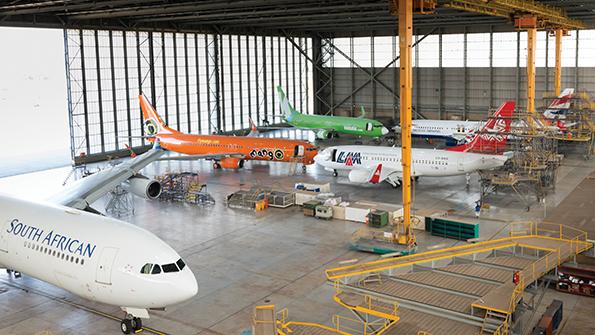
MRO in Africa is locked in a chicken-and-egg paradox. African airlines often lack the scale needed to invest in new MRO capabilities. This means they must look further afield for MRO services, adding substantial time and cost and reducing their ability to grow. This completes the paradox, as limited demand keeps MRO costs high and blocks local investment. But some of the continent’s larger airlines are now looking to break this cycle.
“Many foreign MROs, based in Europe, supply expensive maintenance services to African air carriers. Therefore, African airline maintenance costs are higher than the world average,” explains Gaoussou Konate, consulting director for technical and operations at the African Airlines Association (AFRAA), which represents 44 airlines across the continent.
Konate recalls how some European airlines faced a similar critical-mass dilemma in the 1970s, which they overcame through partnerships. He told the story of how KLM, Swissair, Scandinavian Airlines (SAS) and French carrier UTA formed an aircraft maintenance cooperative, called the KSSU Consortium. Each airline took on different maintenance tasks for the group, rationalizing facilities and costs. KLM and Swissair handled D checks, while KLM and SAS performed engine work, and UTA specialized in landing gears.
“Because of the current individual airline fleet sizes, this cooperation became irrelevant for European airlines. However, African operators could consider this type of technical cooperation,” Konate says.
When it comes to MRO, African airlines fall into two broad groups. The first is made up of airlines that perform their own line maintenance, A checks and some equipment overhauls such as brakes and wheels, but outsource everything else. The second group is composed of larger airlines, which perform comprehensive in-house maintenance, including hangar work, heavy checks and complex equipment overhauls such as avionics and engines.
Konate expects that African MROs could partner and pursue complementary specializations, to support the first group and create economies of scale for the second group, cutting costs on both sides.
AFRAA is looking to help African MROs gain this momentum through the Brown Condor Initiative (BCI), which aims to generate revenue by selling African MRO capacity and surplus spare parts to the U.S. market. BCI was formed in 2020 and launched in 2021 as a partnership between AFRAA and UTD Aviation Solutions.
Kenya Airways, Ethiopian Airlines, South African Airways (SAA) and EgyptAir were all invited to join BCI, because they fly to the U.S. and have FAA- or European Union Aviation Safety Agency (EASA)-approved MRO facilities. Ethiopian Airlines signed up to BCI in April 2022. “More MROs will join this vital initiative in the future,” Konate says.
African airlines also often face additional complexity when introducing newer aircraft types, even when these aircraft are well-accepted elsewhere.
Abdelhamid Addou, CEO of Royal Air Maroc (RAM), says his airline is unable to deploy Boeing 737 MAXs in some African markets, because local MROs are still unfamiliar with the type.
“We have the same problem with Embraers when we fly to some African destinations. We lack maintenance because they obviously don’t know Embraers very well,” he says. “It is much more complicated with an Embraer in some African destinations than [with] the Boeings.”
ROYAL AIR MAROC
Royal Air Maroc’s maintenance operation has been active since the airline was founded in 1957. Now RAM is looking to develop its MRO services further by adding Boeing 737 MAX and 787 heavy-check capability.
“We are working to develop internal capabilities to accommodate 737 MAX and 787 heavy checks,” says Mohammed Lafrem, RAM’s head of aircraft maintenance. “Some of these actions will happen this year.”
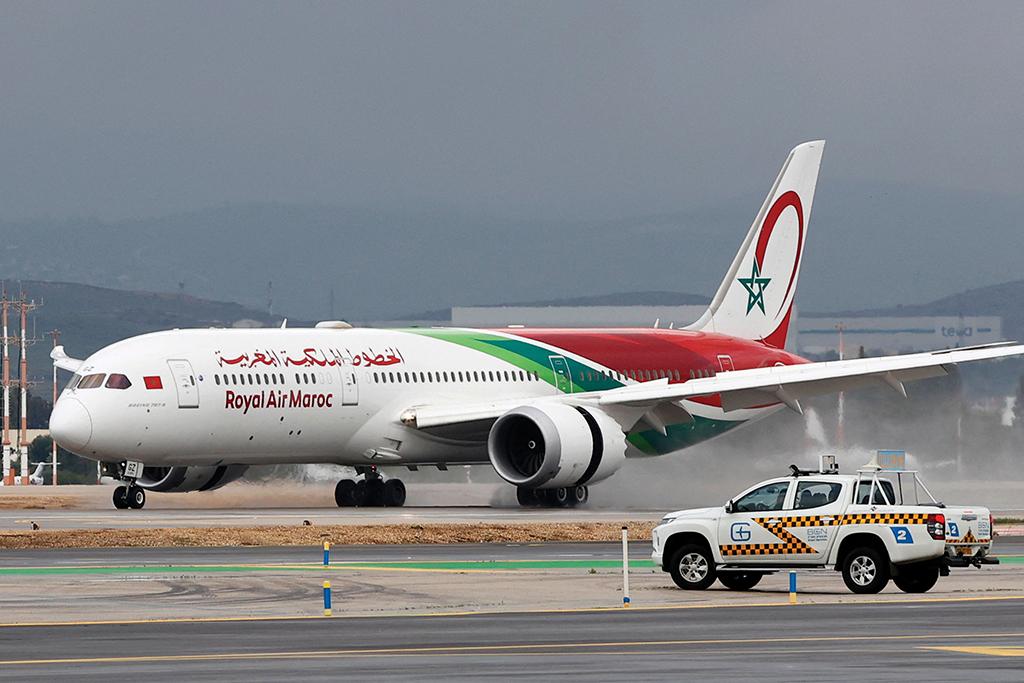
RAM performs line and base maintenance for all its aircraft types, which include the ATR 72-600, Embraer 190, and Boeing 737-800, 737 MAX 8, 787-8/-9 and 767-300F.
The airline also has two significant MRO partnerships. The first of these is with Casablanca-based Aerotechnic Industries, which is a 50-50 joint venture with AFI KLM E&M. This partnership, which dates back 30 years, is active in A320 and 737NG overhauls from A to D checks. RAM’s second joint venture is with Safran Aircraft Engine Services Morocco, which performs CFM56-7B engine work.
“For heavy maintenance checks, we also work with other MROs that we consider as partners, such as Aerostar (Romania) for 737s [for] 12 years now, and Atlantic Air Inc. (Morocco) for ATR 72s [for] nine years,” says Lafrem.
RAM uses General Electric for GEnx engine support, and its long-haul fleet is maintained by a range of suppliers, including Turkish Technic, Sabena Technics, SASCO and Etihad.
Lafrem argues that Africa needs to grow its long-haul aircraft heavy maintenance capabilities. “All of our hangar-only maintenance work is carried out in Europe and Asia, given the lack of such establishments in Africa. To solve this situation, I believe that the construction of more hangars adapted to long-haul aircraft could be a start, because the personnel and expertise in such fleets is not lacking resources in the African airlines,” he says.
Beyond this, RAM is rolling out a mentoring scheme to support trainee technicians, and new career paths have been developed for various maintenance roles.
RAM’s MRO arm is also seeking to develop other maintenance partnerships in the near future. “We are open to join any initiative that can add value to RAM operations,” Lafrem says.
EGYPTAIR
EgyptAir Maintenance & Engineering is a 90-year-old business that is focused on new technology. The company is actively working on digitalization and adding a new paint shop.
“EgyptAir Maintenance & Engineering inherited the legacy of EgyptAir’s technical division,” Yehia Zakaria, chairman and CEO of Egyptair Maintenance & Engineering says.
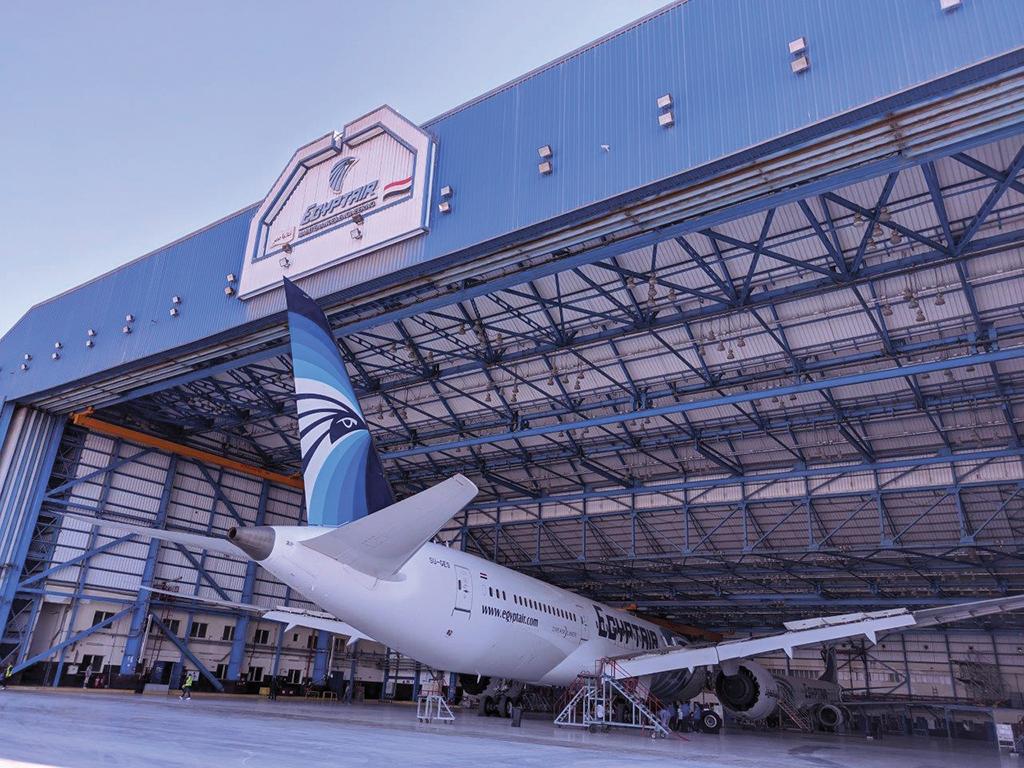
Over nine decades, the division has built up capabilities in line maintenance, light and heavy checks, aircraft modifications, engine support and testing, landing gear replacements, component maintenance (including wheels and brakes), avionics support, borescope inspections, cabin refurbishments, aircraft painting, storage and teardown.
“We made a good leap during the pandemic, over the past couple of years, by intensifying our training programs and adding more aircraft types to our line maintenance capabilities, such as the A380, A350 and A320neo with Pratt & Whitney engines, along with an intensive training plan for component workshops staff,” Zakaria says.
The company has 12 hangar slots, covering narrowbody and widebody aircraft and is able to perform work on Embraer E170s and E190s, Airbus A300s, A310s, A220s, A320-family aircraft (including ceos and neos), A330s, A340s, A350s, A380s, Boeing 737 classics and NGs, 757s, 767s, 777s, and 787s.
Zakaria says the division has now achieved an initial milestone in its digital transformation, streamlining operational processes and giving greater integration with OEM and airline customer systems.
“This will provide the solid foundation to introduce the new digital-based predictive maintenance,” he says.
EgyptAir already performs third-party work for customers in Europe, Africa and the Middle East for 20% of its revenues. Zakaria expects this to grow to 30% in the near future.
Regional collaboration and partnerships are also a priority, enabling the company to add new services, build its regional footprint and grow its customer base.
“In addition, we [plan to] increase our light and heavy maintenance capacity to fulfill the growing regional demand for such services, along with developing a new paint facility,” he says.
SOUTH AFRICAN AIRWAYS
South African Airways Technical (SAAT) is exploring partnerships and new ways of doing business, including some diversification into nonaviation work, following a turbulent period for the SAA group companies.
SAA entered court-led restructuring in December 2019 and suspended scheduled flying from mid-April 2020 until September 2021. Meanwhile, SAA low-cost carrier Mango has not been operational since July 2021. This has had a knock-on impact on SAAT.

Since resuming operations, SAAT has renewed its EASA and FAA licenses and is now working to get back on track after 18 months of challenges and uncertainty.
“The organization’s restructuring seeks to position SAAT as a viable business entity,” says Stanley Ratala, SAAT head of sales and marketing. “SAAT is already implementing its strategy, and we are working toward seeing benefits of new ways of working by the end of the 2022-23 financial year. SAAT is confident that our turnaround strategy and interventions will be successful.”
Cost-reduction efforts, revenue growth and organizational improvements have been focal areas. A contracts committee has also been created to keep an eye on margins and make sure that projects are completed on time and on budget.
The company is also in talks with MROs, OEMs, lessors and suppliers over future collaborations, including strategic partnerships. Ratala says SAAT remains 100% owned by SAA and is seen as “a strategic entity” in South Africa’s aviation strategy.
SAAT performs aircraft airframe, engine and component maintenance for Airbus A320-family aircraft, A330ceos/neos, A340s, A350s and A380s, Boeing 737 Classics/NGs, 747s, 767s, 777s and 787s, along with engine work on each of these types. The company is also active in electroplating, aircraft painting, welding, composite repairs and nondestructive testing.
“SAAT currently uses about 80% of its capacity, and the majority of this utilization is in the line and base maintenance division,” Ratala says. “There is a huge improvement in the workshop activities, because of strategic engagement with other operators, locally and in the region. We have further diversified our revenue streams for the workshops by providing support to nonaviation operators, with our specialized process in plating, machining, surface treatment and specialized inspections.”
Currently, SAAT outsources some work to Israel Aerospace Industries, Lufthansa Technics and SR Technics, as well as engine overhaul maintenance when required.
“African MROs lack engine and component overhaul capability and capacity. Both African airlines and MROs need to aggressively build this capability and forge partnerships with engine OEMs to build these capabilities,” Ratala says.
SAAT has been approached to participate in AFRAA’s Brown Condor Initiative. “SAAT is willing to discuss and join initiatives that will assist business recovery,” he says.
SAAT is also supporting young African engineers through its youth program. This project aims to upskill disadvantaged young people, predominantly from rural areas, and help them develop skills to improve their earning potential.
The MRO has more than 120 young people enrolled in its apprenticeship programs. Over the past three years, more than 200 students have graduated from SAAT training programs spanning 11 trade disciplines.
ETHIOPIAN AIRLINES
Ethiopian Airlines has a simple strategy: “Double it.” Back in 1995, Ethiopian decided to double its passengers, cargo, revenues, network and fleet within five years, under an ambitious plan called Vision 2010. They achieved this target ahead of schedule. This long-term plan was updated to become Vision 2025—and now Vision 2035. Each time, the plan has been to more than double everything.
“Today we have the largest [FAA- and EASA-approved] MRO facility in Africa, and our capabilities include full maintenance of all the aircraft types that we operate,” says Mesfin Tasew, CEO of Ethiopian Airlines.

Ethiopian’s fleet includes the De Havilland Dash 8-400, Airbus A350, Boeing 737NG, 737 MAX, 767, 777 and 787. The airline’s in-house MRO performs heavy checks on all these types, plus GE GEnx work on its 787s and CFM International CFM56-7 overhauls for its 737NGs.
At the 2022 Farnborough Airshow, Tasew detailed plans to grow Ethiopian’s 135-aircraft fleet to more than 250 aircraft by 2035. He also announced a tentative agreement with De Havilland Canada for two Dash 8-400 large cargo door conversion kits, with options on two more. If the deal is confirmed, the conversions would be performed by Ethiopian’s in-house MRO, which is already a De Havilland Canada Authorized Service Facility.
“In August, we’ll be adding the first 767 freighter converted by Ethiopian Airlines. We have a plan to convert two more 767 aircraft and add them into our cargo operation,” he says.
Tasew also signed a seven-year landing gear repair and exchange agreement with Boeing, covering 19 of the airline’s older 787s. “We are almost at the final stage to [gain competency to] repair the Boeing 737NG landing gear. But, unfortunately, the 787 being a new-technology aircraft, we don’t have the capability for the landing gear. That is why we are seeking the services of Boeing,” Tasew says.
Ethiopian’s MRO division currently has an annual turnover of $100 million, performing relatively little third-party work.
“We have been aggressively growing for the last 10-15 years and Vision 2035 will be even more aggressive,” Kidus Melkamu, managing director of Ethiopian MRO Services says. “In terms of third-party, we will grow to $1 billion by 2035.”
This will be generated from airframe, engine, component and line-maintenance, as well as landing gear overhauls and other services. Ethiopian has already begun performing MRO work for airlines in the Middle East, and Melkamu is hoping to attract more customers from Europe and Asia.
Ethiopian is adding MRO capacity to accommodate this rapid growth. The company currently has six airframe maintenance bays, and two new hangars are being built, adding another two bays. This work should be completed within the next 16-20 months.
Melkamu also wants to expand engine-overhaul capacity from five to eight bays within a year or two.
“We are developing Leap-1B capability, so that will be very interesting. With the return to service of MAX, we are expecting a lot of airlines to continue operating this aircraft. We will be one of the few [Leap-1B] shops in the world, so we’ll take advantage of that,” he says. “We should be okay to start the first [Leap-1B] engine by December.”
Ethiopian reintroduced the 737 MAX into service in spring 2020, following the fatal accident that led to the type being grounded for a little more than three years. The carrier has 24 MAXs on order, to be delivered over the coming four years.
Melkamu says Ethiopian is not very active in third-party component maintenance, but the company is growing its pool and developing EASA- and FAA-approved capabilities. A new component maintenance shop is being built and should be ready in 18-24 months.
RWANDAIR
RwandAir, which is based in east-central Africa, is on track to secure Approved Maintenance Organization (AMO) approval before the end of 2022 and is seeking to maximize MRO benefits from its strategic partnership with Qatar Airways.
“As Rwanda is a country without a coast, it is imperative that it develop a strong aviation sector, especially in air operations and aircraft maintenance,” explains Nelson Nabutse, RwandAir’s acting maintenance and engineering director.
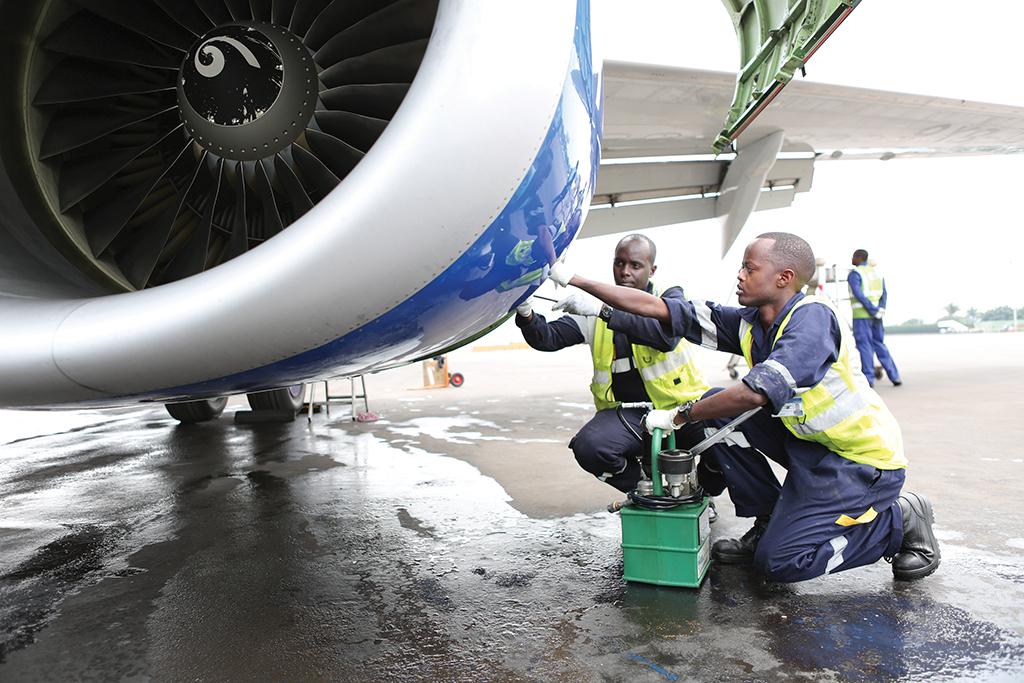
Currently RwandAir uses Ethiopian Airlines to perform A and C checks on its De Havilland Canada Dash 8 Q400s and Boeing 737NGs. Bombardier CRJ900 A and C checks are handled by Samco, while Sabena Aerospace does A checks on RwandAir’s Airbus A330s. C checks for the A330s are outsourced to other suppliers, including Lufthansa Technics and Qatar Airways.
However, RwandAir was launched in 2003, and the airline has now reached a stage where it is seeking AMO approval from the Rwandan CAA (RCAA).
“There are five phases to the certification process, and I am pleased to say RwandAir is at phase 4 of the RCAA AMO approval,” Nabutse says. “The short-term scope of the AMO approval will cover anything up to A checks on our Dash 8-Q400, CRJ900 and 737NG aircraft. The other area that is targeted in the AMO approval is the workshop—which will cover wheels, brakes, aircraft batteries and part CAMO.”
RwandAir is hoping to finalize the AMO approval in the third quarter of 2022, with full fleet coverage up to A checks at its Kigali home base anticipated by the fourth quarter of 2023.
Nabutse says there is a lack of adequate hangars and workshops at the current Kigali International Airport, so base maintenance capability will have to wait until after RwandAir’s relocation to the new Bugesera International Airport, which is expected by 2024. RwandAir will then seek permission to extend its AMO approval.
“The long-term plan is to be able to cover base maintenance up to and including C checks, in addition to component workshops,” he says.
Meanwhile, RwandAir is developing its maintenance skills in partnership with Qatar Airways. The two carriers announced a strategic partnership in 2020, when Qatar detailed plans to take a 49% equity stake in RwandAir.
“Qatar Airways has shown great interest in RwandAir’s MRO growth,” Nabutse says. “More training is planned in the last half of 2022, and Qatar Airways MRO is planning to set up a line maintenance station at Kigali International Airport to support the RwandAir A330 fleet.”
The company is ultimately hoping to offer third-party MRO to other airlines, creating an additional revenue stream and spreading risk. Nabutse also sees AFRAA’s Brown Condor MRO initiative as having great potential.
“RwandAir is evaluating collaboration, and not competition, with other regional MROs, in order to spur growth. The MROs identified include, but are not limited to, Ethiopian MRO, Kenya Airways MRO, Royal Air Maroc MRO, South African Airways Technical, Iberia, Samco and Globalia. The full potential of maintenance partnerships will be realized when RwandAir relocates to Bugesera,” he says.
KENYA AIRWAYS
Kenya Airways acting technical director Gilbert Bett projects there is scope for better utilization of African MRO facilities, as the industry establishes a new post-pandemic normality.
“Kenya Airways MRO has recovered and is currently using about 90% of its MRO capacity, with 20% used for third-party work,” Bett says.
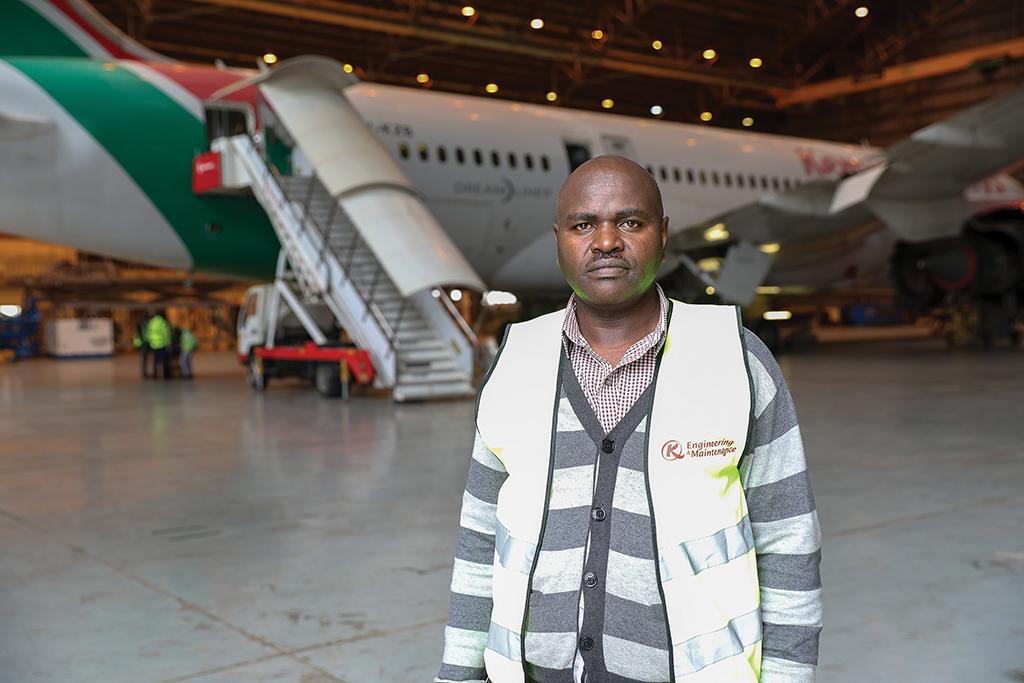
The airline performs line, light and heavy maintenance for the Embraer E170/190, Boeing 737 Classic/NG, 767, 777 and 787, using two main airframe maintenance hangars with simultaneous capacity for three narrowbodies, one widebody and two regional jets.
“We are proud to be the first Sub-Saharan Africa organization to be an Embraer Authorized Service Center,” he adds.
Kenya Airways Engineering & Maintenance also handles component repair, overhaul and servicing, including mechanical, electrical and electronic, avionics and IFE components. The facility has warehouse space for over 100,000 aircraft parts and consumables, as well as dedicated shops for structures, cabin interiors, nondestructive testing, machining and calibration.
This is sufficient to maintain and service Kenya Airways’ fleet, along with some third-party work, although engine and landing gear overhauls are handled externally. U.S. provider AAR recently did some work on Kenya Airways’ 737 landing gears, and the airline’s 787 GEnx engines are maintained by GE.
The division is also making headway in gender equality, employing 98 women among its 450 staff.
Bett is ready to expand maintenance operations in line with demand, but he finds it is important to maximize use of the continent’s existing facilities first. “Africa has all relevant MRO facilities distributed within all its regions, but facilities like aircraft painting and engine overhaul/servicing are not fully utilized,” he says.
Kenya Airways is open to new partnerships, building on an existing cooperation with South African Airways Technical, which makes better use of existing capacity at Nairobi and Johannesburg. The company is also evaluating joining AFRAA’s Brown Condor Initiative.





